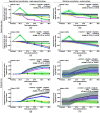Patient-derived cancer organoid tracking with wide-field one-photon redox imaging to assess treatment response
- PMID: 33754540
- PMCID: PMC7983069
- DOI: 10.1117/1.JBO.26.3.036005
Patient-derived cancer organoid tracking with wide-field one-photon redox imaging to assess treatment response
Abstract
Significance: Accessible tools are needed for rapid, non-destructive imaging of patient-derived cancer organoid (PCO) treatment response to accelerate drug discovery and streamline treatment planning for individual patients.
Aim: To segment and track individual PCOs with wide-field one-photon redox imaging to extract morphological and metabolic variables of treatment response.
Approach: Redox imaging of the endogenous fluorophores, nicotinamide dinucleotide (NADH), nicotinamide dinucleotide phosphate (NADPH), and flavin adenine dinucleotide (FAD), was used to monitor the metabolic state and morphology of PCOs. Redox imaging was performed on a wide-field one-photon epifluorescence microscope to evaluate drug response in two colorectal PCO lines. An automated image analysis framework was developed to track PCOs across multiple time points over 48 h. Variables quantified for each PCO captured metabolic and morphological response to drug treatment, including the optical redox ratio (ORR) and organoid area.
Results: The ORR (NAD(P)H/(FAD + NAD(P)H)) was independent of PCO morphology pretreatment. Drugs that induced cell death decreased the ORR and growth rate compared to control. Multivariate analysis of redox and morphology variables identified distinct PCO subpopulations. Single-organoid tracking improved sensitivity to drug treatment compared to pooled organoid analysis.
Conclusions: Wide-field one-photon redox imaging can monitor metabolic and morphological changes on a single organoid-level, providing an accessible, non-destructive tool to screen drugs in patient-matched samples.
Keywords: autofluorescence; cancer organoid; drug screening; image analysis; redox imaging; tracking.
Figures







Similar articles
-
Label-Free Optical Metabolic Imaging in Cells and Tissues.Annu Rev Biomed Eng. 2023 Jun 8;25:413-443. doi: 10.1146/annurev-bioeng-071516-044730. Epub 2023 Apr 27. Annu Rev Biomed Eng. 2023. PMID: 37104650 Free PMC article. Review.
-
Multiphoton FLIM imaging of NAD(P)H and FAD with one excitation wavelength.J Biomed Opt. 2020 Jan;25(1):1-16. doi: 10.1117/1.JBO.25.1.014510. J Biomed Opt. 2020. PMID: 31920048 Free PMC article.
-
Single-cell redox states analyzed by fluorescence lifetime metrics and tryptophan FRET interaction with NAD(P)H.Cytometry A. 2019 Jan;95(1):110-121. doi: 10.1002/cyto.a.23711. Epub 2019 Jan 2. Cytometry A. 2019. PMID: 30604477
-
Autofluorescence lifetime imaging of cellular metabolism: Sensitivity toward cell density, pH, intracellular, and intercellular heterogeneity.Cytometry A. 2019 Jan;95(1):56-69. doi: 10.1002/cyto.a.23603. Epub 2018 Oct 8. Cytometry A. 2019. PMID: 30296355 Free PMC article.
-
Evaluating Cell Metabolism Through Autofluorescence Imaging of NAD(P)H and FAD.Antioxid Redox Signal. 2019 Feb 20;30(6):875-889. doi: 10.1089/ars.2017.7451. Epub 2018 Jan 30. Antioxid Redox Signal. 2019. PMID: 29268621 Free PMC article. Review.
Cited by
-
Engineering strategies to capture the biological and biophysical tumor microenvironment in vitro.Adv Drug Deliv Rev. 2021 Sep;176:113852. doi: 10.1016/j.addr.2021.113852. Epub 2021 Jun 28. Adv Drug Deliv Rev. 2021. PMID: 34197895 Free PMC article. Review.
-
Development of an Endoscopic Auto-Fluorescent Sensing Device to Aid in the Detection of Breast Cancer and Inform Photodynamic Therapy.Metabolites. 2022 Nov 11;12(11):1097. doi: 10.3390/metabo12111097. Metabolites. 2022. PMID: 36422237 Free PMC article.
-
Impact of baseline culture conditions of cancer organoids when determining therapeutic response and tumor heterogeneity.Sci Rep. 2022 Mar 25;12(1):5205. doi: 10.1038/s41598-022-08937-z. Sci Rep. 2022. PMID: 35338174 Free PMC article.
-
Precision medicine research progress based on colorectal cancer organoids.Discov Oncol. 2025 Jun 23;16(1):1181. doi: 10.1007/s12672-025-02959-5. Discov Oncol. 2025. PMID: 40549302 Free PMC article. Review.
-
Volumetric growth tracking of patient-derived cancer organoids using optical coherence tomography.Biomed Opt Express. 2021 Jun 3;12(7):3789-3805. doi: 10.1364/BOE.428197. eCollection 2021 Jul 1. Biomed Opt Express. 2021. PMID: 34457380 Free PMC article.
References
Publication types
MeSH terms
Substances
Grants and funding
LinkOut - more resources
Full Text Sources
Other Literature Sources
Medical

